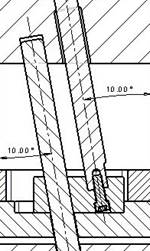The Designer's Edge: Fitting Lifters and Wear Surfaces
Randy discusses pre-load and the role of the moldmaker to ensure the expected outcome, as well as the proper fitting of lifters and wear prevention.

Here is a pre-hard H-13 lifter (40 RC) that gulled up because it was not nitrided.
Randy discusses pre-load and the role of the moldmaker to ensure the expected outcome, as well as proper lifter fitting and wear prevention.
If the lifter has shut-off surfaces on the top (where the stationary half has details with shut-offs on the top of the lifter), pre-load is not as critical. However, too much pre-load can create maintenance issues, such as broken lifter bolts and ejector plates held forward. In a few cases, I have even seen the lifter pre-load vary 0.005 to 0.020 of an inch and still cause tooling issues.
This is the moldmaker's responsibility to address and involves his process for timing lifters. There are various ways to time lifters and adjust pre-load. Although they all work, the moldmaker must pay close attention to detail to ensure the outcome is correct.
The moldmaker must also handle the spotting and fitting of lifters. Lifters with heads and drafted sidewalls should not be too tight. This can cause stressing of the lifter bolts when trying to pull the lifter home. After the lifter is fitted, the moldmaker should be able to push the lifter all the way down and out of the pocket by hand. If this requires a tool to pop it all the way down or to get the lifter out of the pocket, then the fit is too tight. On lifters with square shanks, chamfer the four corners below the cavity surface to provide clearance. I have seen many tines where the corners were not clear enough and resulted in galling.
One other misconception is the idea that pre-hard H-13 lifters (40 RC) do not need hardening. The old standard of 10 points of RC difference for wear surfaces has been proven wrong on the lower RC scale. When running 40 RC on P-20, which is 28 - 30 RC, galling will occur at some point. On the higher RC scale (above 50 RC), spreads can be less than 5 RC. I have had tools run millions of cycles with S7 50-52 RC cavities and 52-54 RC lifters, with no lifter failures.
P-20 or pre hard H-13 can be good base materials for lifters, but always nitride or DynaBlue surface treatment to prevent galling. Coatings can also work, but are not as durable in the long term. When using alloys, coatings are not a necessity but they can improve wear. With one exception, when ver using alloys with glass-filled materials always coat to prevent erosion from the glass fibers.
Next month I will wrap up this series on lifters and review round versus square shanks, decelerated lifter travel and part removal.







.png;maxWidth=300;quality=90)

_300x250 4.png;maxWidth=300;quality=90)




